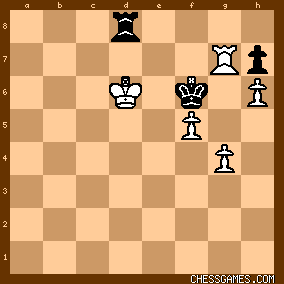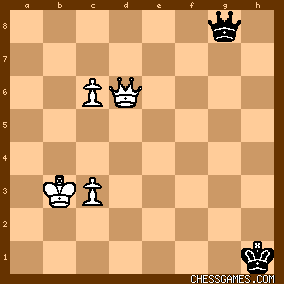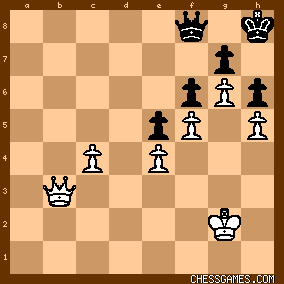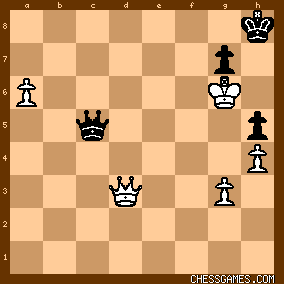|
< Earlier Kibitzing · PAGE 4 OF 4 ·
Later Kibitzing> |
| Apr-13-09 | | YetAnotherAmateur: <Once>It's "sir". And you managed to neglect that the rook was dropping on top of white's king, not his non-existant queen. |
|
| Apr-13-09 | | CHESSTTCAMPS: <Jimfromprovidence:> wrote:
<I don’t know if this game below is the one you meant. This one illustrates the same concept and same result as today's, it’s just more complex.> It's not the one I had in mind, but a very nice puzzle anyway. Thanks. |
|
Apr-13-09
 | | tobywan: I don't see why Rd1+ is not also a draw. That was the solution I came up with. I have thought about this all day, and played the position out against Shredder, which at full strength settled for a draw against me as Black. dzechiel says, <quote>Note that the rook IS NOT to give check on the first rank (74...Re1+?) as that would allow the white king to flee from the edge of the board and find refuge among his own pieces.</quote> but I don't think that the king can go above the second rank. The minute the white king plays, say, Ke3, black does, say, ...Rd3+ followed by ...Rxb3, and the White rook cannot take it. After that it is R+N vs R.
Please tell me where Shredder and I have gone wrong, if we have. I am not as strong as most of you. Thanks. |
|
| Apr-13-09 | | zb2cr: The Rook check moving along the rank works. 73. ... Re2+ and the Rook can't be captured, due to stalemate. |
|
| Apr-13-09 | | Pawnage: <tobywan> It looks to me as well that Re1+ is an elementary draw, same reasons. Rybka agrees with us. Rybka+Shredder, formidable team. |
|
| Apr-13-09 | | Pawnage: Well, I take the above statement back, sorta. Maybe not an 'elementary' draw. I looked it up and its quite possible to botch a rook and knight vs. rook with incorrect play. This was news to me. |
|
| Apr-13-09 | | Amarande: <tobywan> You would be right, in fact, Rd1+ and Re2+ both lead to draws, in this specific case. Rd1+ allows for the possibility of error, however, and therefore is the less desirable move for this reason: 73 ... Rd1+ 74 Ke2 Rd2+ 75 Ke3 Rd3+ 76 Ke4, and now continuing the pattern with Rd4+?? would lose: 77 Ke5 Re4+ 78 Kd6!, and now Black has no effective check. Instead, Black must either play Rxb3 now, or switch to third-rank checks with 76 ... Re3+, which still draws as long as Black is mindful to play Rxb3 at once if White should ever play the King to d6 or d8 (where a d-file check would allow Nd5, and where an adjacent check would allow capture by the Knight). (Of course, other squares on the 6 rank are of no problem to Black while checking on the 3 rank, as a Rook interposition simply loses the Pawn with an obvious dead draw.) On the other hand, Re2+ allows Black to check on the 2nd rank until the cows come home, and as long as he does this there is no possibility whatsoever to make a mistake. Because of this (and it being the actual move) I would have to call this a more proper solution, even though both moves do work. |
|
Apr-13-09
 | | Jimfromprovidence: I found a famous match where the attempt to use a “kamikaze” or "crazy" rook to force a stalemate does not work. Kasparov vs Karpov, 1985 Move 65 for white.

click for larger view
Thanks to....User: Sneaky and a subset of his game collection... Game Collection: Crazy Rooks |
|
Apr-13-09
 | | tobywan: Thank you for confirming my analysis of Rd1+. After looking at the solution, I saw at once that it was superior. I should have looked for a better move after finding only a workable one. |
|
Apr-13-09
 | | OBIT: <An Englishman>I was just looking at exactly the same idea. 71. Nc7+ is asking for trouble, even if it doesn't throw away the win just yet. By playing 71. Rc5 and b4, everything is mutually defended with no danger of stalemate, so the only remaining task is to get the king forward. About the only plan Black has to try to stop this is to shuttle his rook on the 3rd rank, but White breaks this easily by playing Rc3, allowing his king to cross the third rank. |
|
Apr-13-09
 | | OBIT: Uh, well, there WAS a post here from <An Englishman> just a minute ago, honest... |
|
| Apr-13-09 | | UnsoundHero: In this game, White's inaccurate play led to a miracle stalemate defense by Black. But even more amazing than this are games where the inferior side can force a stalemate, and there is nothing that the superior side can do to stop it! Take, for example, this problem:
White: Kf3; Pa3, b2, c3, d3, e4, h3.
Black: Kd8; Pa7, b3, c7, c5, e5, h4.
Black's position looks hopeless. But he has a miracle defense based on stalemate! 1...c4 2 dxc4 c5 3 Kg4 Kc7 4 Kf5 Kb6 5 Kxe5 Ka5 6 Kd5 Ka4 7 Kxc5 a5!. Black draws by stalemating himself! White is in utter agony. He thought he had an easy win. It would be great if chessgames.com would present a future puzzle based on this forced-stalemate theme. |
|
| Apr-13-09 | | Kasputin: <Once: <Kasputin...Here white's b-pawn comes in very handy for black because the black rook could (at some future point) land on b2 with check without being captured by the white rook.>
Take the b pawn away and the drawing combination still works. If white recaptures with the rook, it is still stalemate.> You are quite correct. Thanks for keeping me honest :-) |
|
| Apr-14-09 | | blacksburg: here's a few totally <heartbreaking> stalemate traps, taken from <Van Perlo's Endgame Tactics>, one of my favorite books. Bilek-Heidenfeld 1968

click for larger viewhere, white played 1.c4 (almost any other move wins), and must have been shocked to see 1...Qg3+. draw. Pilnick-Reshevsky 1942

click for larger view1...g4 looks like a decent move, right? black is totally winning, what could go wrong? 1.Qf2, draw, game over. Nesis-Kolker 1975

click for larger viewafter 1...Qg8!, threatening 2...Qxc4 3.Qxc4 stalemate, white had to accept that he could make no progress, draw. <and finally, a demonstration of why chess players quit the game.> Efimov-Fedoruk 1978

click for larger viewblack played 1...Qd5!, and white was unable to bring himself to accept the draw by stalemate after, for instance, 2.Qe2 Qe6+. so, blinded by his desire to win, white played 2.Qa3? and got <checkmated> after 2...Qe6+ 3.Kxh5 Qf5#! let these examples be a lesson to us all - when you think your position is won, you still need to calculate. also, you should run to the amazon.com and buy <Van Perlo's Endgame Tactics>, because it's a great book! |
|
| Apr-16-09 | | TheaN: Monday 13 April (delayed)
<73....?>
Material: +/♘&♙\ w: ♖ & ♘ & ♙ b: ♖ (ENDGAME)
Candidates: <[Re2†]> Target: 0:30
Taken: 0:17
Par: yes
NOTE: these 'taken' times are actually inclusively the tab/window switch, as I'm using an online stopwatch :P. -ML-
Not too hard this Monday (solved on Thursday due to a tactical archive problem :P), it is clear Black should draw. Because of the fact that his King is in stalemale, he can draw by simply checking the White King on the second rank over and over again... <77....Re2† 78.Kf1 Rf2† 79.Kg1 Rg2† 80.Kxg2 1/2> ...and when the King finally captures, it's stalemate. Crucial for such 'wild Rook' positions is that White should not have the option of taking with a piece that would simultaneously lift the stalemate, in this case the Knight. Ironically, remove the pawn and Black can still do the same, i.e after Kd1, Kc1, Kb1: 80....Rb2† 81.Rxb2 is still stalemate. Nice Monday draw. |
|
| Apr-16-09 | | TheaN: 2/2
Make it all from move 73 though :P. |
|
| Apr-18-09 | | patzer2: For the Monday April 13, 2009 puzzle solution, 73...Re2+! leads to a clever stalemate draw. |
|
| Aug-29-09 | | WhiteRook48: kf2?? |
|
| Sep-02-14 | | Garech: Ha! Great game. This should be GOTD someday too! "Suttles" has great pun potential, I'll put my thinking cap on. -Garech |
|
| Oct-19-15 | | jerseybob: 73.Ke1? is the big mistake, allowing the king to be trapped on the first rank, unable to escape stalemate. 73.Ke3!is the move. But as I always say about J'adoubovich, it couldn't happen to a nicer guy! |
|
Oct-19-15
 | | perfidious: <jerseybob> You know what they say about payback, and Suttles was the b***h. |
|
| Oct-19-15 | | jerseybob: <perfidious> Yes he was. I remember years ago some GM trashed Suttles, calling him an "idiot" or some such thing, but he was anything but! |
|
| Oct-15-16 | | lentil: The final drawing combination is amazing, but so is the whole game. Suttles' use of the minor pieces and later the advanced pair of passed pawns to build counterplay are (IMHO) even more intersting. |
|
| Jun-12-20 | | rwbean: Doesn't look good with modern computers, blunders all over the place, but fun at the end ... winning moves
19. f4
23. ♘xa7
25. ♘bxd6 vs 25. f3??
27... ♕g3+
28... ♘g3
29. ♔g1
38. ♖e4
47. ♖h3+
53. ♘f6 +8
62.♘d5+ mate in 32 (probably 30 or less) ...
62.Nd5+ Kc6 63.Ne7+ Kc7 64.a7 Ra2+ 65.Kf3 Ra6 66.Rc8+ Kb7 67.a8=Q+ Rxa8 68.Rxa8 Kxa8 (and the 6-man tablebases kick in, like in some of the other comments) but my favourite is
63. ♘a4!! mate in 16 ... 63... bxa4 64. b4! (every other move is a draw or worse) |
|
| Jun-12-20 | | Granny O Doul: @jerseybob: On 73. Ke3, Black should still hold with ...Rd3+ and ...Rxb3. |
|
 |
 |
|
< Earlier Kibitzing · PAGE 4 OF 4 ·
Later Kibitzing> |
|
|
|





